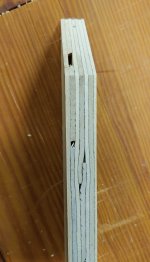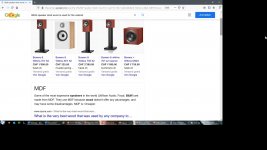This week I am building a new garden shed. I was cutting some BCX plywood, and I examined a cut-off. Notice the overlapping plies, and the gaps... There were other inner-ply gaps that were as much as an inch in length.
If this material were used in a speaker cabinet wall, it is possible, or even probable, that vibration would cause "buzzing" or "rattling" as the plies moved against each other.
Only use void-free plywood for the walls and baffles. In my area, that means baltic birch or marine-grade fir plywood. Cabinet grade AB plywood is generally void free, but I have sometimes found small voids.
If this material were used in a speaker cabinet wall, it is possible, or even probable, that vibration would cause "buzzing" or "rattling" as the plies moved against each other.
Only use void-free plywood for the walls and baffles. In my area, that means baltic birch or marine-grade fir plywood. Cabinet grade AB plywood is generally void free, but I have sometimes found small voids.
Attachments
During the 1960s and 1970s Ampeg (musical instrument amplifier manufacturer) sent all of their plywood through an ultrasonic scanner to detect voids or other irregularities. Only perfect sheets were used for speaker cabinets or combo amps. The rest were used for head cabinets or dollies.
I heard some say: Do not use Plywood for Speaker Cabinets...
Use MDF - and you show the best Evidence why, in that picture..
Thanks for posting.. Plywood makes the sound boomy like it comes out of a thrash can... similar for me at least. And I do not want to offend anyone who is using plywood
Use MDF - and you show the best Evidence why, in that picture..
Thanks for posting.. Plywood makes the sound boomy like it comes out of a thrash can... similar for me at least. And I do not want to offend anyone who is using plywood
I heard some say: Do not use Plywood for Speaker Cabinets...
Use MDF - and you show the best Evidence why, in that picture..
You use quality plywood. Lots of plies (15 in 18mm) and no voids. Much superior to MDF. IMO MDF is not really suitable for loudspeaker boxes unless that is all you can get. Its only real asset is that it is cheap.
dave
I have worked as a furniture carpenter and there is a difference, plywood for furniture is much better than other grades but also more expensive, furniture plywood is often a little heavier in their standard thicknesses.
The different ratings also reveal which errors you can count on BCX that you have used allows you to have all the "errors" that you show there should be a nice side and a worse one that is in between can look any way. A furniture AB should have one side without any defects the other may be a little worse but each layer should be faultless.
The different ratings also reveal which errors you can count on BCX that you have used allows you to have all the "errors" that you show there should be a nice side and a worse one that is in between can look any way. A furniture AB should have one side without any defects the other may be a little worse but each layer should be faultless.
Yes the utility plywood available at the big box stores is very unpredictable, sometimes decent quality but often having large areas either never glued or delaminated, significant voids, etc. For furniture quality work (and I include speakers here) you need to find a plywood retailer who stocks high quality material. They will typically focus on supplying local cabinet shops. I recently purchased 3 sheets of walnut 3/4" (19mm) high quality plywood for a floating entertainment console I am working on for our new home. I went to a small plywood retailer I have used for 20+ years. The face veneers are beautiful, rotary cut on the show side and plain sliced and book matched on the back side. It was $150 for a 4'x8' (122x244cm) sheet but when you consider the time spent on a project skimping on materials is a fool's errand.
but when you consider the time spent on a project skimping on materials is a fool's errand.
What he said.
dave
Are you sure about PLYWOOD,
OK, I have following to say:
JBL BEYMA, I.Q Series, B&W Shelf Series and many others are all made with MDF
Reason MDF is RESONANCE NEUTRAL, not likewise Plywood..
OH BTW also Vandersteen Audio, and many other Brands..
Check out the Pics Please, Regular Plywood is not very welcome for Speaker Cabinets.
BTW Also earlier MARANTZ Speaker Cabinets before Marantz was sold or manufactured in JAPAN.
Like the HD880 SERIES were all made of MDF. I owed for a long time a SET of HD880, in the nineties.
Also DynAdio, Audac and many more,, all MDF
OK, I have following to say:
JBL BEYMA, I.Q Series, B&W Shelf Series and many others are all made with MDF
Reason MDF is RESONANCE NEUTRAL, not likewise Plywood..
OH BTW also Vandersteen Audio, and many other Brands..
Check out the Pics Please, Regular Plywood is not very welcome for Speaker Cabinets.
BTW Also earlier MARANTZ Speaker Cabinets before Marantz was sold or manufactured in JAPAN.
Like the HD880 SERIES were all made of MDF. I owed for a long time a SET of HD880, in the nineties.
Also DynAdio, Audac and many more,, all MDF
Attachments
Last edited:
MDF has two advantages, it's very dense and it's cheap. It also has a litany of disadvantages, it doesn't work at all well with threaded fasteners, edge gluing is problematic, edge finishing is fussy, it has zero moisture tolerance, and on. Worst of all using it for projects is the clouds of hazardous dust produced when working with it. Proper structural design is the answer for any concerns about resonance. BTW, it's popularity with manufacturers might just go back to that "it's cheap" quality.
I hope you usually do just a little bit more searching to get your information then just believe the first random answer that pops up in Google.
That's just not a good way of informing yourself.
Wilson uses Methacrylic/Ceramic compounds, and other epoxy based materials. Most high end B&W cabinets also do not use MDF.
I don't want to get into the what's better discussion, but at least base your opinion on facts.
That's just not a good way of informing yourself.
Wilson uses Methacrylic/Ceramic compounds, and other epoxy based materials. Most high end B&W cabinets also do not use MDF.
I don't want to get into the what's better discussion, but at least base your opinion on facts.
There is no void-free plywood available in India from domestic makers. No one makes it because there's no demand for it.
Sangram,
I've used Greenply branded Gurjan wood marine ply which was made in India. Found it pretty good.
IIRC it was 11 layers atleast for 18mm thickness, and with relatively very few voids. Very dense and heavy; and the splinters were very sharp too. 🙂
The price was higher than standard ply though. You can check it out.
I've used Greenply branded Gurjan wood marine ply which was made in India. Found it pretty good.
IIRC it was 11 layers atleast for 18mm thickness, and with relatively very few voids. Very dense and heavy; and the splinters were very sharp too. 🙂
The price was higher than standard ply though. You can check it out.
5 Types of sheet material
1) 3/4" Baltic birch with Urea glue - Excellent thickness uniformity. Nice for machining. Great for Speakers.
2) 1" Baltic Birch with Phenolic glue - Same as 1 and will not delaminate when exposed to heavy moisture for long periods. Scraps buried outside for 2 years and when dried off are in the same condition as new.
3) 1/2" Ultra Core softwood plywood - It has 1/8 mdf layer on both faces. The 3/4" is my preference for flat rectangle box speakers that are to be painted. Mitered corners required.
4) 3/4" Veneer Core poplar faced plywood - Great for workshop cabinets or other projects where a nice veneer face is preferred. Although the price is close to BB so maybe just step up to BB.
5) 3/4" Chinese Birch - Complete Garbage. Twisted, not a uniform thickness. outer veneer is extremely thin. voids etc etc.. I read that people have found metal inside some sheets.. I just tried one sheet and will never buy it again.
IMO, MDF adds little or no value to sound performance. It's the overall design that counts and BB with holed braces, damping materials, etc, will do the job wonderfully.. IME, the use of MDF by larger manufacturers is simply related to its low cost, workability and is a suitable material for CNC routers..Of course they will BS you into thinking it has some sonic value.
The dust should be avoided like the Plague!
1) 3/4" Baltic birch with Urea glue - Excellent thickness uniformity. Nice for machining. Great for Speakers.
2) 1" Baltic Birch with Phenolic glue - Same as 1 and will not delaminate when exposed to heavy moisture for long periods. Scraps buried outside for 2 years and when dried off are in the same condition as new.
3) 1/2" Ultra Core softwood plywood - It has 1/8 mdf layer on both faces. The 3/4" is my preference for flat rectangle box speakers that are to be painted. Mitered corners required.
4) 3/4" Veneer Core poplar faced plywood - Great for workshop cabinets or other projects where a nice veneer face is preferred. Although the price is close to BB so maybe just step up to BB.
5) 3/4" Chinese Birch - Complete Garbage. Twisted, not a uniform thickness. outer veneer is extremely thin. voids etc etc.. I read that people have found metal inside some sheets.. I just tried one sheet and will never buy it again.
IMO, MDF adds little or no value to sound performance. It's the overall design that counts and BB with holed braces, damping materials, etc, will do the job wonderfully.. IME, the use of MDF by larger manufacturers is simply related to its low cost, workability and is a suitable material for CNC routers..Of course they will BS you into thinking it has some sonic value.
The dust should be avoided like the Plague!
Attachments
-
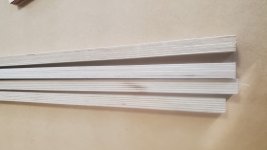 Three quarter inch BB with urea glue.jpg145.4 KB · Views: 310
Three quarter inch BB with urea glue.jpg145.4 KB · Views: 310 -
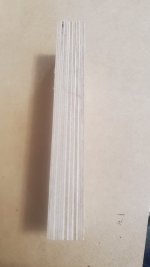 One inch BB with phenolic glue.jpg104.6 KB · Views: 253
One inch BB with phenolic glue.jpg104.6 KB · Views: 253 -
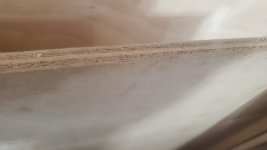 One half inch Ultra Core with MDF layer on both faces.jpg91 KB · Views: 251
One half inch Ultra Core with MDF layer on both faces.jpg91 KB · Views: 251 -
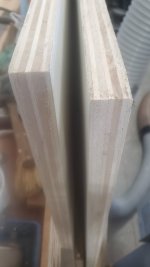 Poplar Veneer with laminate core.jpg97.1 KB · Views: 253
Poplar Veneer with laminate core.jpg97.1 KB · Views: 253 -
 Chinese garbage plywood.jpg86.4 KB · Views: 251
Chinese garbage plywood.jpg86.4 KB · Views: 251
Last edited:
It also has a litany of disadvantages, it doesn't work at all well with threaded fasteners, edge gluing is problematic, edge finishing is fussy, it has zero moisture tolerance, and on. Worst of all using it for projects is the clouds of hazardous dust produced when working with it.
Its like stating all cars are unreliable. That very much depends on the quality and origin of MDF - if from the EU it would most likely be close to zero hazardous but at the same time weak in structure and won`t hold screws well. If from outside the EU (so it doesn`t abide to class E1 for hazardousness) it may be very tough, dense and hold screws very well but one has to wear a mask when working with it. In my opinion it is the lesser evil of most materials - plywood tends to chirp a lot and may get excited easily, besides, its glues would be subject to the same EU norms. I absolutely hate routing plywood and finishing corners on a non-square box may be much more problematic than for MDF in my opinion.
Modern mdf (at least the sheets conforming to modern EU standards) isn't much worse than plywood wrt chemical toxicity. Fine dust is best avoided in any case but that is true when working with high speed power tools on any wooden material. MDF just makes it more obvious by producing a lot more dust.
There are also many grades of mdf. Frankly, the best ones aren't any cheaper than plywood.
There are also many grades of mdf. Frankly, the best ones aren't any cheaper than plywood.
Sangram,
I've used Greenply branded Gurjan wood marine ply which was made in India. Found it pretty good.
I've used that too 🙂
Actually I use it very often for furniture, and for small speakers which don't have much bass.
It's still not guaranteed void-free though, which is the point. We do get Baltic Birch at exorbitant premium, so I generally stick to MDF. It's not that I haven't built with ply, but I prefer to avoid it whenever possible.
What I like to use is the exterior grade, which for some brands uses as high as 20% plastic granules. This absorbs much less moisture and is generally much stiffer and heavier than Grade II boards. Dust is roughly the same, but woodworking is almost always outsourced and the folks who make my cabinets use proper protection (they build PA bins so know how to handle drivers etc.)
Around here, I've used several grades of MDF. The best and worst are the same price at around $35, it come down to the supplier. Home depot had the worst quality.
Slower speeds with larger steel cutters on BB produces shavings with a lower amount of fine dust. MDF requires High speed carbide cutters that are not as sharp as steel cutters. High speed, carbide and MDF results in fine Talcum powder dust.🙁
Slower speeds with larger steel cutters on BB produces shavings with a lower amount of fine dust. MDF requires High speed carbide cutters that are not as sharp as steel cutters. High speed, carbide and MDF results in fine Talcum powder dust.🙁
I hope you usually do just a little bit more searching to get your information then just believe the first random answer that pops up in Google.
That's just not a good way of informing yourself.
Wilson uses Methacrylic/Ceramic compounds, and other epoxy based materials. Most high end B&W cabinets also do not use MDF.
I don't want to get into the what's better discussion, but at least base your opinion on facts.
My Dear friend, I have Series 2000 Shelf Speaker B&W and I'm almost positive that these are MDF, but of course I will take a look tonight when I'm home. No problem, I wouldn't write but I had them open just a while ago, I know the back and the front are not but as I remember the sides are, I will check that, I can be as well wrong and mistaken, of course if this is the case, my apologies .. No problem at all.
Anyway thanks for mention it.,.
We never stop to learn.
- Home
- Design & Build
- Construction Tips
- Why it is important to avoid construction grade plywood
